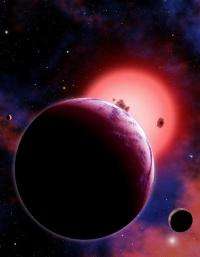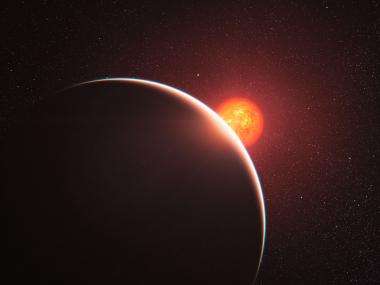Super-Earth has an atmosphere, but is it steamy or gassy?

In December 2009, astronomers announced the discovery of a super-Earth known as GJ 1214b. At the time, they reported signs that the newfound world likely had a thick, gaseous atmosphere. Now, a team led by Jacob Bean (Harvard-Smithsonian Center for Astrophysics) has made the first measurements of GJ 1214b's atmosphere. However, the measurements raise as many questions about the planet's atmospheric composition as they answer.
"This is the first super-Earth known to have an atmosphere," said Bean. "But even with these new measurements we can't say yet what that atmosphere is made of. This world is being very shy and veiling its true nature from us."
A super-Earth is a planet up to three times the size of Earth and weighing one to ten times as much. (GJ 1214b is 2.7 times the size of Earth and 6.5 times as massive.) They are likely to be mostly solid (some combination of rock or ices), unlike the hundreds of Jupiter-sized gas giants found to date around distant stars.
Researchers suggested three atmospheric possibilities for GJ 1214b. The most intriguing was a thick blanket of steam vaporized by the nearby star. (This option led to the nickname "waterworld," although it's too hot for an ocean.) The second option was a mini-Neptune with a rocky core surrounded by ices and a hydrogen/helium atmosphere. The third model has no equivalent in our solar system - a big, rocky world with a soupy mix of gases (mainly hydrogen) recently emitted by volcanoes.
To study the planet's atmosphere, the team observed it when it crossed in front of its star. During such transits, the star's light filters through the atmosphere. Gases absorb the starlight at particular wavelengths, or colors, leaving behind a chemical fingerprint detectable from Earth. Similar observations have found gases like hydrogen and sodium vapor in the atmospheres of distant "hot Jupiters."
"This is the first super-Earth to have its atmosphere analyzed. We've reached a real milestone on the road toward characterizing these worlds," stated Bean.
Commenting on the work, Harvard astronomer David Charbonneau, who is not involved in the recent study but led the team that discovered GJ 1214b, agreed. "In less than 10 years, we've gone from studying the atmospheres of alien worlds like Jupiter, to Neptunes, to super-Earths. Earth-sized worlds are next, although they'll be the most difficult."

The spectrum of GJ 1214b proved to be featureless, which ruled out a cloud-free atmosphere composed primarily of hydrogen. If the atmosphere of GJ 1214b has abundant hydrogen, then it must be cloaked by a thick blanket of clouds (like Venus) or haze (like Saturn's moon Titan). A dense, steamy atmosphere also fits the data.
"It would have to be very dense - about one-fifth water vapor by volume," explained Bean. "Compared to our Earth, with an atmosphere that's four-fifths nitrogen and one-fifth oxygen with only a touch of water vapor."
The team examined GJ 1214b in the near-infrared region of the spectrum (780 - 1000 nanometers) using the ground-based Very Large Telescope at Paranal Observatory in Chile. Additional observations in the mid- or far-infrared might finally answer the question: Is the atmosphere of GJ 1214b steamy or gassy?
"A lot of people are putting this planet under a microscope," said Bean. "In the next year, we should have some solid answers about what it's truly like."
Provided by Harvard-Smithsonian Center for Astrophysics





















